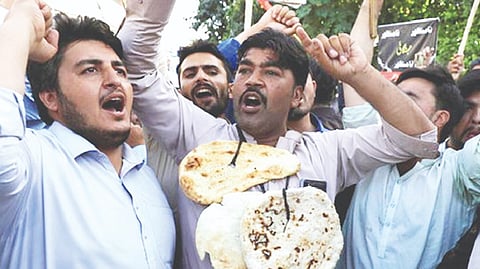

NEW YORK: As Pakistan marks 75 years of independence this weekend, Islamabad has not planned any special events, aside from a flag-raising ceremony, a fireworks display in the capital and the introduction of a new 75 rupee (€0.34/$0.35) note.
However, 75 rupees doesn’t buy what it used to. Inflation data from July released last week showed Pakistan’s Consumer Price Index surged nearly 25% compared to last year, with consumers struggling to bear the soaring costs of basic essentials like food and energy.
The economic turmoil is putting heavy pressure on Pakistan’s new government, which is currently in long-running negotiations with the International Monetary Fund on a bailout deal to stave off a disastrous default on foreign debt.
Husain Haqqani, a former Pakistani ambassador to the United States, told DW that Pakistan’s economic dysfunction is rooted in deep structural problems dating back decades.
Pakistan remains a net importer of goods and services, and its industrialization has not expanded sufficiently to close the gap.
The ratio between tax collection and GDP as well as between exports and GDP for Pakistan is also among the lowest in the world.
This means that the government faces a persistent shortage of revenue, and the country confronts a perennial shortage of foreign exchange.
“Successive Pakistani leaders made the choice of depending on foreign aid while building military capacity, ignoring the fundamentals of economics,” said Haqqani, who is currently director for South and Central Asia at the Hudson Institute, a think tank in Washington, D.C.
However, it wasn’t always like this. According to renowned economist Kaiser Bengali, Pakistan pursued robust development and created a vast amount of economic assets in the years following independence in 1947.
Bengali told DW that after Pakistan opened more to foreign interests around the year 2000, government spending and imports began to far exceed tax revenues and exports, with the gap made up by foreign loans.
“Today, loans are contracted only to repay past loans — none for any development projects,” he said.
Less government revenue means shrinking resources for public services, which in turn contributes to political instability.
In April, former premier Imran Khan was ousted from office in a no-confidence vote after being blamed for mismanaging the economy over his three years in office.
Khan claimed he was “overthrown” by a “US-backed, imported government.” His supporters took to the streets in protest, and Khan remains a destabilizing political force.
Khan’s successor, Shehbaz Sharif, has faced an uphill battle with a fractured polity and floundering economy.
As the Sharif government negotiates with the IMF on debt relief, it has removed fuel subsidies in a bid to increase public revenue. His detractors have accused him of selling out ordinary Pakistanis to the benefit of foreign creditors.
Farzana Bari, a rights activist and academic, told DW that over decades Pakistan’s ruling classes have served the “colonial interests of the ruling elite,” which cut out marginalized communities and the larger public.
“Successive governments have not spent on human resources, primarily education and health,” she said, adding that there are hopes for Pakistani youth to create a stronger civil society and bring the country on a “progressive path.”
To move forward, analyst Haqqani said Pakistanis will “need to move beyond conspiracy theories and ideological narratives, and instead seek to focus attention on building Pakistan’s human capital, economic potential, and political institutions.”
Visit news.dtnext.in to explore our interactive epaper!
Download the DT Next app for more exciting features!
Click here for iOS
Click here for Android